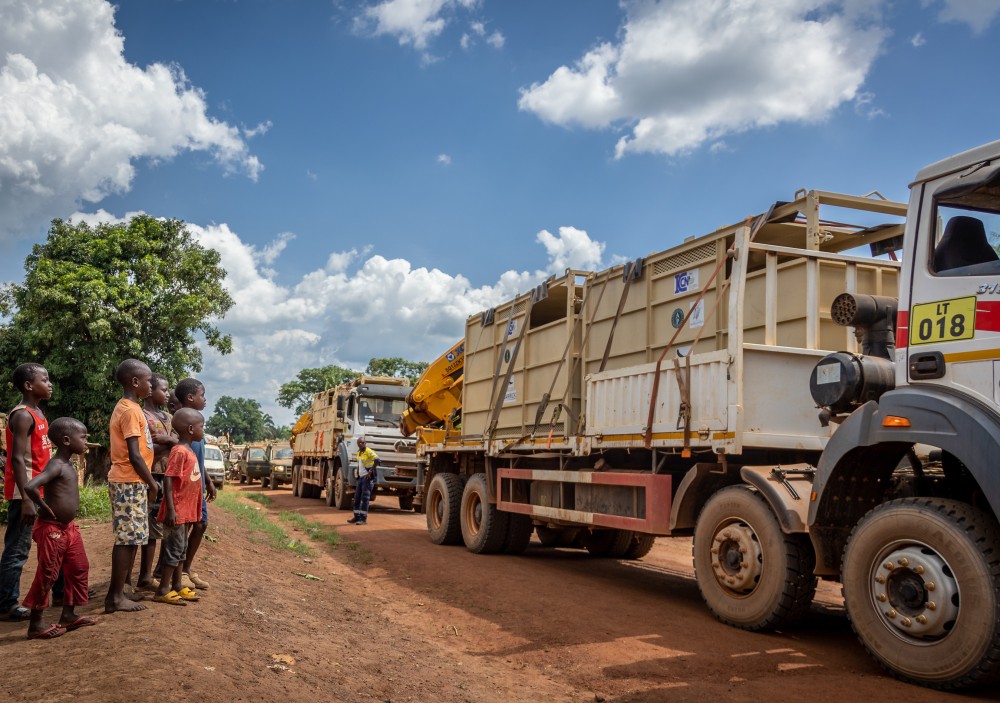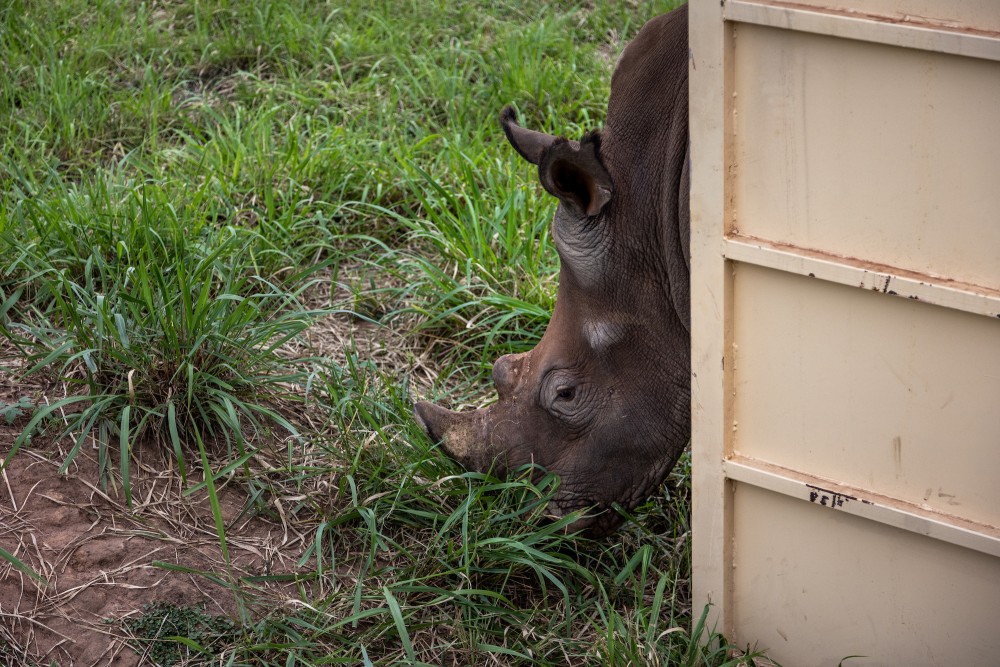Relocating White Rhinos to Garamba National Park Renews Hope for the Species and the Park
Between 3rd and 9th of June 2023, 16 southern white rhinos were translocated from andBeyond Phinda Private Game Reserve in South Africa to Garamba National Park in the Democratic Republic of the Congo (DRC). This move is part of an ongoing wildlife restoration project within the Garamba Complex (GC) to restore mega-herbivore back to the region. With the loss of the northern white rhino in the country, African Parks plans to gradually restore the ecological functions of the park by bringing southern white rhino to the region in a series of reintroductions. This translocation was done in collaboration with Conservation Solutions, which has moved over 4,000 rhino across the continent, and in partnership with the Government of the Democratic Republic of the Congo, the Institut Congolais pour la Conservation de la Nature (ICCN), andBeyond and Barrick Gold Corporation as the key sponsor who has undertaken to support the project over the next few years.
The Restoration of Garamba National Park
Situated in the north-eastern corner of the DRC, Garamba National Park is listed as a UNESCO World Heritage Site and characterised by savanna and equatorial forest. Once home to over 20,000 elephant and thousands of other species, the area endured many years of being overrun by rebels and ivory poachers, leading to plummeting wildlife numbers by the turn of the century.
In 2005, the ICCN invited African Parks to help manage the park and create a safe haven for the people and wildlife. The challenge that lay ahead was huge and between 2005 and 2016 instability in the region continued to threaten communities and wildlife. During this time, African Parks, together with the ICCN, revised its approach by implementing new systems to overhaul conservation law enforcement and bring stability to the park and its surrounds. Since then, wildlife numbers in the park have increased with each year, while communities are realising the benefits from stability in the region.
Originally home to the northern white rhino, Garamba has seen no signs of the species in nearly two decades. In its place, the reintroduction of southern white rhino to Garamba is part of the long-term vision of the protected area to create ecological sustainability through healthy ecosystems.
 © Martin van Rooyen
© Martin van RooyenWhy is it important to move Rhino to Garamba?
Translocating white rhino from South Africa to the Garamba National Park not only promotes the long-term conservation of rhino in Africa by extending their range, but also creates another breeding node for the species in a safe environment. With the disappearance of the endemic northern white rhino, the habitat in Garamba has changed significantly over the past decade with a loss of “grazing lawns”, originally maintained by rhino. These lawns are a vital source of sustenance and habitat for other grazers, as well as being instrumental in fire management by creating natural fire breaks. By re-establishing rhino back into the Garamba, the park’s mega-herbivore populations will be restored to ensure a healthy ecosystem.
How do we know that Garamba is a safe destination for these rhinos?
Since African Parks assumed management of Garamba in 2005, elephant poaching has significantly decreased and most wildlife populations are showing positive population increases. By developing socio-economic initiatives in and around Garamba, the amount of people engaged in illegal activities has decreased as alternative sources of income are found. As a result, security in Garamba has improved as dependency on the park’s natural resources has been alleviated. Adding to this, Garamba’s conservation law enforcement efforts to counter poaching threats has become highly effective through ongoing ranger training and the use of Earthranger technology.
Why is it important to create a healthy white rhino population in Garamba?
As a keystone species, white rhino play an important role in regulating the structure and functioning of the ecosystem in which they exist. By introducing white rhino to Garamba, important ecological processes that have been diluted over the last decades due to the lack of rhino impact will be restored, such as the recreation and maintenance of grazing lawns and natural fire breaks which in turn positively affect the wellbeing of other species in the environment.
 © Martin van Rooyen
© Martin van Rooyen What are the risks around rhino translocations?
Moving large live animals always involves risks for both people and the animals and must be carefully managed every step of the way. This is particularly true where they involve large-scale moves over significant distances. As a result, years of extensive planning are undertaken to ensure the wellbeing of the rhino throughout the translocation process. A team of experts oversee the transit, constantly monitoring the animals, with every measure taken to ensure their health and reduce their stress. The first risk is darting the rhino for initial capture and their reaction during this process. Respiratory depression is always a risk. To manage this, a team of specialist vets oversee and monitor each rhino during the entire process-and if needed, administer medication to alleviate any respiratory difficulties.
Security during transport is also a major concern and requires careful management with a security escort that accompanies the convoy between locations.
On arrival the rhino are kept in a boma for an initial period of adjustment before being released into a larger area for an extended period. During this time, they are monitored daily by an on-site specialist rhino vet as they acclimatise to the new environment. Eventually they will be fitted with transmitters to enable ongoing close monitoring after being fully released into the park.
What has African Parks learnt from previous rhino translocations?
Moving wild animals into new environments is always a risk. For this reason, time and expertise go into assessing the viability of the move, including the needs and adaptability of the species in the new area. To replace a species that has become locally extinct, time is required for the animals to adapt to local conditions, and this can take many years. During this period, there is always a risk that some individuals will not adapt as well as others and may die as a result. However, when this happens, the surviving animals allow a micro-population of the species to begin thriving in the new environment and ultimately ensure the population can grow in the future.
In the case of Garamba National Park, a species-specific management plan has been developed together with a rigorous monitoring programme. Staff have been trained and national capacity is being developed to ensure the adequate monitoring and management of the white rhino population.
An onsite vet is available to treat the animals in the holding boma facilities or in the field if any clinical signs of illness begin to show. The rhino are also provided with supplementary feed and mineral licks to prevent nutritional stress. Other measures to ensure success include the control of tsetse fly disease, timing the reintroduction during the regrowth of grasses at the start of the wet season and recreating grazing lawns through mowing.
 © Martin van Rooyen
© Martin van RooyenWhat does a successful rhino translocation look like?
The initial measure of success will be when the first calves are conceived in the DRC, born and weaned, followed by a consistently growing population that exhibits comparable growth rate, sex and age structure, and social stability.
What is African Parks’ rhino translocation track record?
African Parks has undertaken several rhino translocations, reintroducing the species to Majete Wildlife Reserve in Malawi in 2006; to Akagera National Park in Rwanda in 2017 (followed by another five animals in 2019); Zakouma National Park in Chad in 2018; translocations to boost populations in Liwonde National Parkand Majete Wildlife Reserve in Malawi in 2019; and in the largest ever rhino translocation, African parks moved 30 white rhinos from South Africa to Akagera National Park in Rwanda in November 2021. These translocations have contributed to the expansion of rhino range and numbers in Africa. While four rhinos were lost in Zakouma following the translocation in 2018, every possible measure was undertaken to establish the exact ecological factors that contributed to their mortalities and to mitigate risks in future translocations.
12 June 2023 - African Parks
Your Support Goes a Long Way
At African Parks we are working everyday to protect Africa's last wild landscapes. By donating to us, you are making a difference and are giving hope to people and wildlife across the continent.
Donate